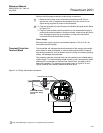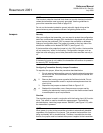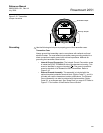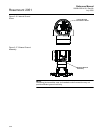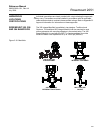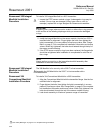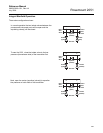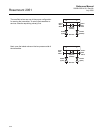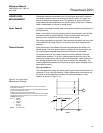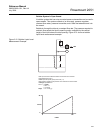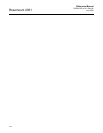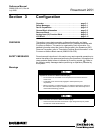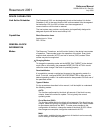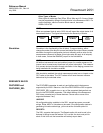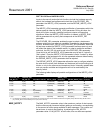
Reference Manual
00809-0200-4101, Rev AA
July 2008
2-31
Rosemount 2051
LIQUID LEVEL
MEASUREMENT
Differential pressure transmitters used for liquid level applications measure
hydrostatic pressure head. Liquid level and specific gravity of a liquid are
factors in determining pressure head. This pressure is equal to the liquid
height above the tap multiplied by the specific gravity of the liquid. Pressure
head is independent of volume or vessel shape.
Open Vessels A pressure transmitter mounted near a tank bottom measures the pressure of
the liquid above.
Make a connection to the high pressure side of the transmitter, and vent the
low pressure side to the atmosphere. Pressure head equals the liquid’s
specific gravity multiplied by the liquid height above the tap.
Zero range suppression is required if the transmitter lies below the zero point
of the desired level range. Figure 2-19 shows a liquid level measurement
example.
Closed Vessels Pressure above a liquid affects the pressure measured at the bottom of a
closed vessel. The liquid specific gravity multiplied by the liquid height plus
the vessel pressure equals the pressure at the bottom of the vessel.
To measure true level, the vessel pressure must be subtracted from the
vessel bottom pressure. To do this, make a pressure tap at the top of the
vessel and connect this to the low side of the transmitter. Vessel pressure is
then equally applied to both the high and low sides of the transmitter. The
resulting differential pressure is proportional to liquid height multiplied by the
liquid specific gravity.
Dry Leg Condition
Low-side transmitter piping will remain empty if gas above the liquid does not
condense. This is a dry leg condition. Range determination calculations are
the same as those described for bottom-mounted transmitters in open
vessels, as shown in Figure 2-19.
ZERO
SUPRESSION
mA dc
20
540
900
inH
2
O
4
Figure 2-19. Liquid Level
Measurement Example.
Let X equal the vertical distance between the minimum and maximum
measurable levels (500 in.).
Let Y equal the vertical distance between the transmitter datum line and the
minimum measurable level (100 in.).
Let SG equal the specific gravity of the fluid (0.9).
Let h equal the maximum head pressure to be measured in inches of water.
Let e equal head pressure produced by Y expressed in inches of water.
Let Range equal e to e + h.
Then h = (X)(SG)
= 500 x 0.9
= 450 inH
2
O
e=(Y)(SG)
= 100 x 0.9
=90 inH
2
O
Range = 90 to 540 inH
2
O
T
Y
X



